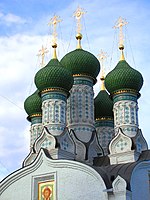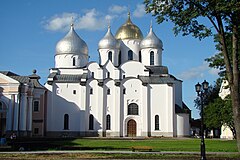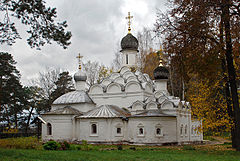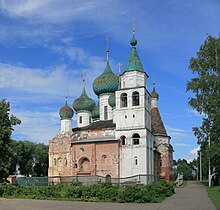Russian church architecture
The first churches in Kievan Rus', such as the 13-domed wooden Cathedral of St. Sophia, Novgorod, differed in this regard from their mainly single-dome Byzantine predecessors.
The late 12th century saw the development of so-called tower churches in Polotsk and Smolensk; this design later spread to other areas such as Kiev and Chernihiv.
A visual transition between the main cube of the church and the elongated cylinder below the dome was provided by one or several rows of curved corbel arches, known as kokoshniki.
The churches of Pskov were tiny and gabled; they developed an enclosed gallery which led to a porch and a simple belfry, or zvonnitsa.
Detached belfries with tent roofs are exceedingly common in the 17th century; they are often joined to the church by a gallery or a low elongated narthex.
The mystic environment cultivated through church services is enhanced through the regulation of light, movement, smoke, and sound.
"[5] Intended to induce an awareness of the divine on Earth, the rituals of the Russian Orthodox Church are organized so as to engage all five senses.
Pavel Florensky notes the comprehensive and sensual nature of the aesthetic experiences offered through Russian Orthodox liturgy in his 1922 article "The Church Ritual as a Synthesis of the Arts".
The architectural components of Orthodox churches work so as to emphasize all the sensory aspects of the worship service – down to the smoke emanating from the burning incense – in order to provide worshippers with an experience of the godly.
Icons, and the sense of divinity that they invoke through their visual beauty, are a part of the architectural structure of Russian Orthodox churches.
The mosaics, murals, and icons that are installed on the church iconostasis define the wall as a spiritual barrier that can only be crossed by the clergy.
[11] Florensky refers to "wall-painting" as "that noblest form of fine art" to be found in Russian Orthodox churches.
Visually, the wall art of the church provides a greater sense of immersion with the divine for the parishioners; this is further enhanced through the usage of the iconostasis to protect the mystery of the sacraments.
This is a list of Russian masonry church types as they evolved away from the squat Byzantine models of the 11th century and acquired a pronounced tendency toward the vertical.






